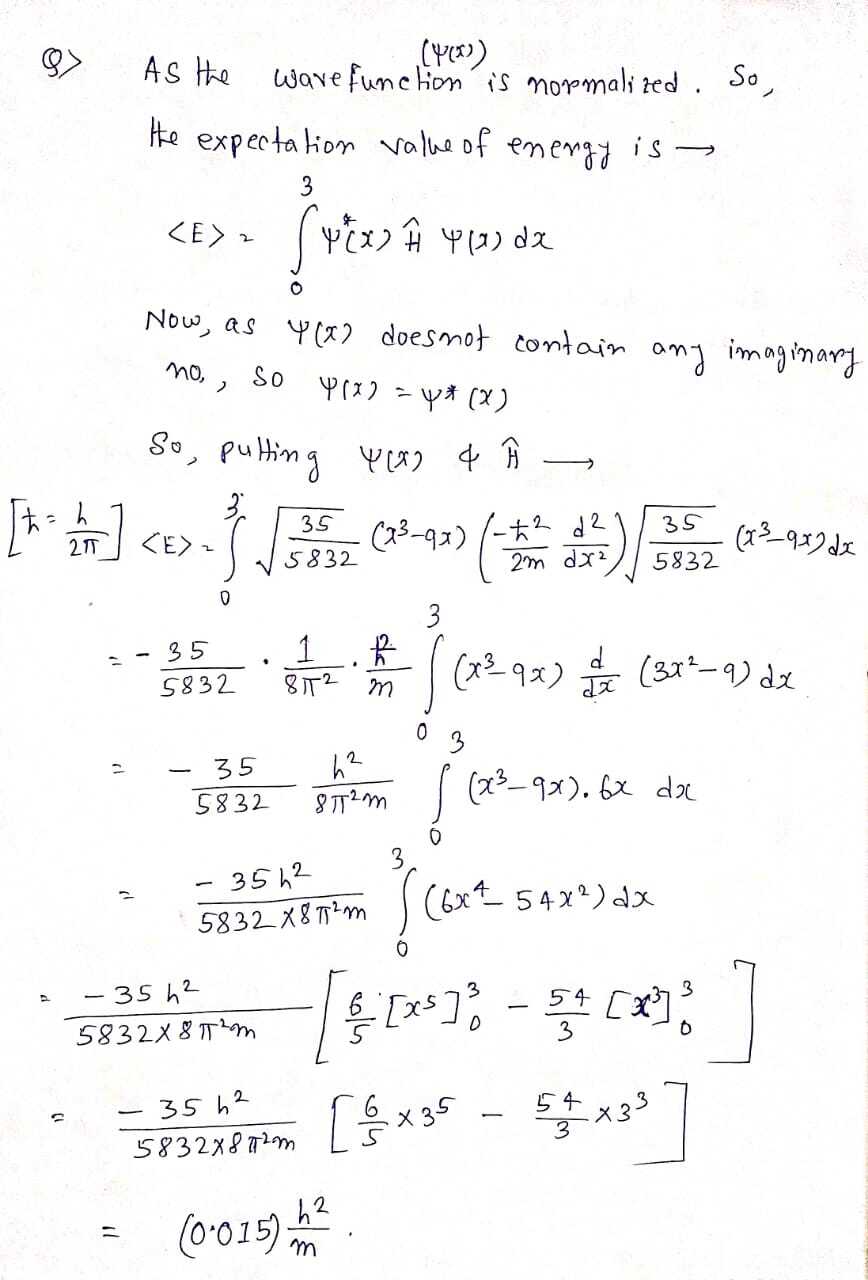Consider a 1D particle in a box confined between z = 0 and z = 3. The Hamiltonian for the particle inside the box is simply given by Ĥ *4 Consider the following normalized wavefunction 2m dr²° ¥(x) = / (x³ – 9x). Find the expectation value for the energy of the particle inside the box. Give your 35 3832 final answer for the expectation value in units of (NOTE: h, not hbar!). In your work, compare the expectation value to the lowest energy state of the 1D particle in a box and comment on how the expectation value you calculated for the wavefunction ¥(x) is an example of the variational principle.
Consider a 1D particle in a box confined between z = 0 and z = 3. The Hamiltonian for the particle inside the box is simply given by Ĥ *4 Consider the following normalized wavefunction 2m dr²° ¥(x) = / (x³ – 9x). Find the expectation value for the energy of the particle inside the box. Give your 35 3832 final answer for the expectation value in units of (NOTE: h, not hbar!). In your work, compare the expectation value to the lowest energy state of the 1D particle in a box and comment on how the expectation value you calculated for the wavefunction ¥(x) is an example of the variational principle.
Chemistry
10th Edition
ISBN:9781305957404
Author:Steven S. Zumdahl, Susan A. Zumdahl, Donald J. DeCoste
Publisher:Steven S. Zumdahl, Susan A. Zumdahl, Donald J. DeCoste
Chapter1: Chemical Foundations
Section: Chapter Questions
Problem 1RQ: Define and explain the differences between the following terms. a. law and theory b. theory and...
Related questions
Question

Transcribed Image Text:Consider a 1D particle in a box confined between a = 0 and x = 3. The Hamiltonian for the particle inside the
box is simply given by Ĥ
. Consider the following normalized wavefunction
2m dz²
¥(2) =
35
(x³ – 9x). Find the expectation value for the energy of the particle inside the box. Give your
5832
final answer for the expectation value in units of (NOTE: h, not hbar!). In your work, compare the expectation
value to the lowest energy state of the 1D particle in a box and comment on how the expectation value you
calculated for the wavefunction ¥(x) is an example of the variational principle.
Expert Solution
Step 1

Trending now
This is a popular solution!
Step by step
Solved in 2 steps with 2 images

Knowledge Booster
Learn more about
Need a deep-dive on the concept behind this application? Look no further. Learn more about this topic, chemistry and related others by exploring similar questions and additional content below.Recommended textbooks for you

Chemistry
Chemistry
ISBN:
9781305957404
Author:
Steven S. Zumdahl, Susan A. Zumdahl, Donald J. DeCoste
Publisher:
Cengage Learning

Chemistry
Chemistry
ISBN:
9781259911156
Author:
Raymond Chang Dr., Jason Overby Professor
Publisher:
McGraw-Hill Education

Principles of Instrumental Analysis
Chemistry
ISBN:
9781305577213
Author:
Douglas A. Skoog, F. James Holler, Stanley R. Crouch
Publisher:
Cengage Learning

Chemistry
Chemistry
ISBN:
9781305957404
Author:
Steven S. Zumdahl, Susan A. Zumdahl, Donald J. DeCoste
Publisher:
Cengage Learning

Chemistry
Chemistry
ISBN:
9781259911156
Author:
Raymond Chang Dr., Jason Overby Professor
Publisher:
McGraw-Hill Education

Principles of Instrumental Analysis
Chemistry
ISBN:
9781305577213
Author:
Douglas A. Skoog, F. James Holler, Stanley R. Crouch
Publisher:
Cengage Learning

Organic Chemistry
Chemistry
ISBN:
9780078021558
Author:
Janice Gorzynski Smith Dr.
Publisher:
McGraw-Hill Education

Chemistry: Principles and Reactions
Chemistry
ISBN:
9781305079373
Author:
William L. Masterton, Cecile N. Hurley
Publisher:
Cengage Learning

Elementary Principles of Chemical Processes, Bind…
Chemistry
ISBN:
9781118431221
Author:
Richard M. Felder, Ronald W. Rousseau, Lisa G. Bullard
Publisher:
WILEY